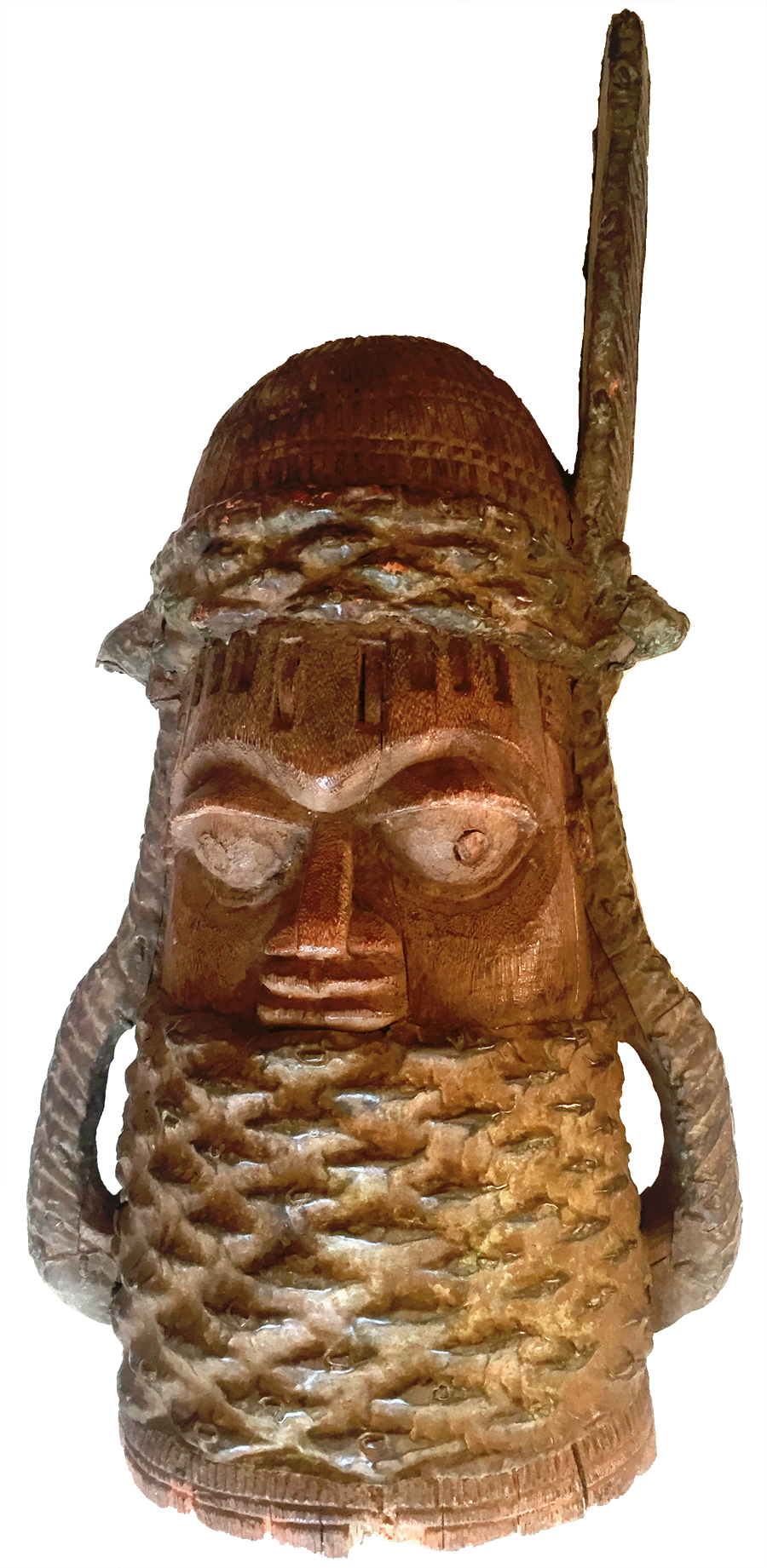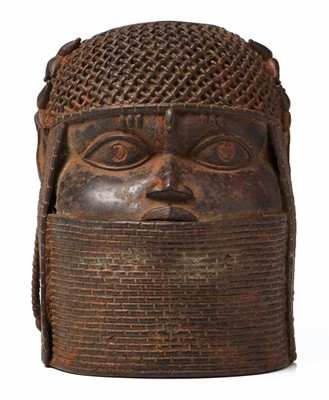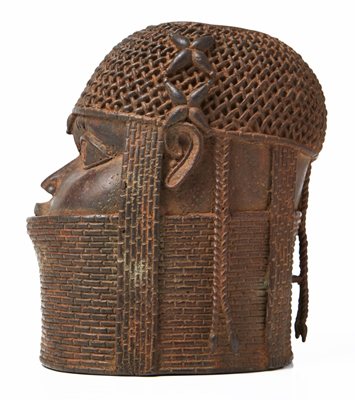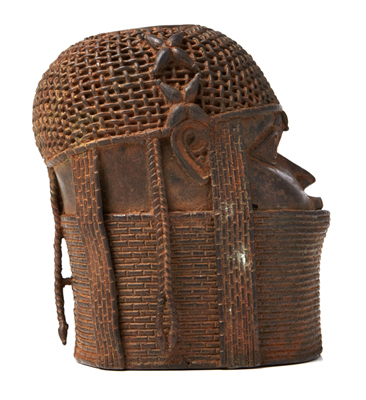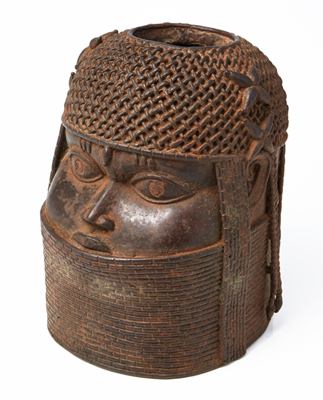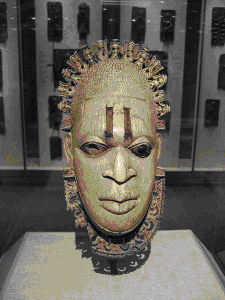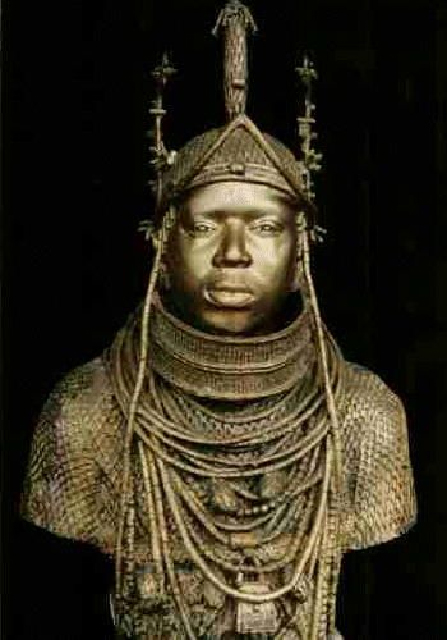
African and Tribal Art Object 1 |
||||
Benin Head of Enekidi |
|
|||
A Highly Important Benin Head of Enekidi, Carved wooden commemorative trophy head covered partially with copper sheet. The hollowed head rising from a cylindrical neck encircled by 11 rows of pod shaped beads leaving the mouth exposed, the face with small flaring nose, delicately modeled lips and wide oval eyes with round pupils, six raised scarification lines above the eyes and two larger rectangular lines above the inner corner of each eye (ikao), framed by flat diminutive ears and wearing a headdress with additional 3 rows of pod shaped beads and one row of coral beads on top, one braid behind the left and one braid behind the right ear, each terminating in a single coral bead, exceptionally fine, the copper surface varied gold brown patina. In perfect condition. History: It was a time of warfare and conquest, expansion, consolidation and development of the kingdom of Benin under the kings Ewuare, Ozolua, Esigie, Orhogbua and Ehengbuda. The kingdom of Benin extended in the east to the Niger River, in the west to Lagos, in the north-east to Ekiti and Owo and north-west included the Ishan area. Such heads were exposed only on the shrines of very high-ranking chiefs and it allude to their power over life and death. Height: 28 1/2 in. 72.5 cm |
||||
Object 2 |
||||||
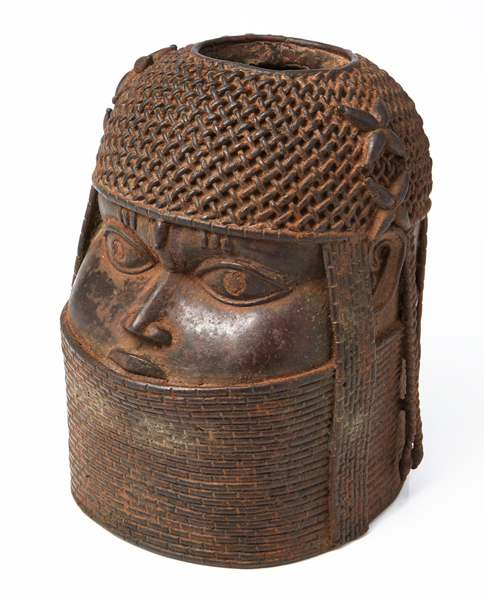 A Magnificent and Highly Important Benin Head of an Oba, Nigeria, circa 1490-1570 |
|
|||||
A Magnificent and Highly Important Benin Head of an Oba,
Nigeria, circa 1490-1570 Cast, the hollowed form rising from a cylindrical neck encircled by 22 rows of coral beads, the face with delicately modeled lips, small flaring nose and wide oval eyes inset with iron for the pupils, three raised scarification lines above the eyes and a fourth larger rectangular line inset in iron above the inner corner of each eye (ikao), framed by flat diminutive ears and wearing an elaborate headdress with coral beads in a crisscross pattern with additional groups of five pod shaped beads attached to the surface, and eleven strands of beads at each side, two braids behind the left and one braid behind the right ear, each terminating in a single coral bead; in white pigment on reverse of head; mounted on rotating Inagaki base; exceptionally fine, varied gold brown patina with traces of red pigment. A similar one was sold on 17th may 2007 at Sotheby’s, New York (lot 121) on the AFRICAN, OCEANIC AND PRE-COLUMBIAN ART SALE http://www.sothebys.com/en/auctions/ecatalogue/lot.121.html/2007/african-oceanic-and-pre-columbian-art-n08320 Height: 24.8 cm Wide: 19 cm
Literature: |
||||||
Provenance (june 2024)
|
||||||
Authentication and Evaluation Certificate
This bronze ceremonial head of an Oba is very similar to the example in The British Museum. Evolved from a thin cast, the hollowed form rising from a cylindrical high neck collars encircled by 22 rows of coral beads of Benin court dress. The face with delicately modeled lips, wide oval eyes and small flaring nose, three raised scarification lines above the eyes and a fourth larger rectangular line above the inner corner of each eye ( ikao ), framed by flat diminutive ears and wearing an sophisticated headdress with coral beads in a crisscross pattern with additional 4 groups of four pod shaped beads attached to the surface, and thirteen strands of beads at each side, one braid behind the left and one braid behind the right ear and one braid on reverse of head each terminating in a single coral bead. Exceptionally fine, varied gold brown patina with traces of brown clay. The figure is in much better condition than the almost similar example sold on 17 May, 2007 at Sotheby's, New York for 4,744,000 USD: (lot 121) on the AFRICAN, OCEANIC AND PRE-COLUMBIAN ART SALE http://www.sothebys.com/en/auctions/ecatalogue/lot.121.html/2007/african-oceanic-and-pre-columbian-art-n08320
Thermoluminescence certificate No: 02B010419 by Laboratory Ralf Kotalla. www.kotalla.de
EVALUATION A realistic appraisal of today's value of this highly important Benin Head should be: not less than 5,000,000 USD.
PROVENANCE Acquired and owned by a French Officer Pierre Deruelle based in North Africa during the World War 2, remained in Africa during the 1950's, later lived in Provence in France. Purchased from the above in Paris in March, 1965 by the Swedish judge Haardefelt. From the above inherited by the recent owner.
HISTORY When Oba Esigie ascended the throne in 1504, Great Benin, also known as Edo, was an important state that flourished in southern Nigeria of today. For about 46 years that he was in power, Esigie was well known for his literacy, hospitability and his abilities as a communicator to the extent that he would establish peaceful relations with Portuguese ambassadors, as well as, other Christian missionaries. This made him the first leader in the West-African Sub-Region to establish diplomatic relations with a European country while his son became the first accredited African envoy to Portugal court. Despite this relationship, efforts made by Europeans to have access to the hinterland to benefit from its rich natural resources did not materialize as Esigie never allowed them to.
Oba Esigie, the powerful ruler of the Benin Kingdom
Born to Oba Ozolua's and Iyoba Idia in 1504, Esigie was named Prince Osawe, but after succeeding his father to the throne, he took the title of Oba Esigie. He was at loggerheads with his brother, Idubor, who argued that his birthright was taken away from him. According to history, Idubor's mother gave birth to him a few hours before Esigie was born. However, because Idubor did not immediately cry at birth, Esigie, who did was reported first to the king and his proclamation rights were performed. This tradition angered Idubor, who would go to war with his brother on several occasions before he was finally defeated. Esigie would go on to reign over the ancient Benin Kingdom while maintaining a strong connection to Portugal throughout his reign. Becoming the first leader in the West-African Sub-Region to establish diplomatic relations with a European country, Esigie encouraged extensive trade with the Europeans though ensuring that his kingdom was independent of their control. Accounts state that Esigie sold slaves to the Portuguese, the French, and later the English. This became a major business in the kingdom as its armies captured people from other West African kingdoms towards that purpose. “At this time the Portuguese described Esigie's capital as a city with a nine-mile wall around it. As several historians have pointed out, this description reveals that Benin was a wealthy trading center, but its great wall suggests that it had many enemies and was plagued by unrest and instability,” writes Encylopedia . com . At a point in time, Portuguese agents tried to talk Esigie into acquiring firearms from Portugal for future campaigns. But this came with a clause. The Portuguese king wrote Esigie, explaining to him that: “When we see that you have embraced the teachings of Christianity like a good and faithful Christian, there will be nothing within our realms which we shall not be glad to favour you, whether it be arms or cannon and all other weapons of war for use against your enemies; of such things we have a great store, as your ambassador Dom Jorge will inform you.” But Esigie paid deaf ears to this, and in 1516, even without Portuguese arms, he defeated the Igala to the north, who had tried to invade his kingdom. Esigie forced the defeated Igala to pay reparations. Nevertheless, the Portuguese king was able to send missionaries to Benin who successfully converted the Oba's son to the Christian faith. A few churches were also established in the kingdom even though Christianity became a minority religion. The powerful Esigie, meanwhile, has his mother to thank for his successful reign over Benin . His mother, Idia, was a strong influence on him as he “undertook nothing of importance without having sought her counsel.”
Esigie introduced a special post in the administration for his mother called the Iyoba, the Queen Mother, and commissioned a “highly improved metal art” that has since received wide acclaim. The famous Queen Mother Idia busts are some of the most well-known art pieces. Idia's image is also expressively captured in the famous Ivory mask, which served as the logo of the 2nd World Black and African Festival of Arts and Culture (FESTAC), held in 1977 in Lagos , Nigeria . “The exquisite craftsmanship of the mask bears testimony to the quality of life and superlative level of civilization of the Benin people prior to their colonization,” an article by Trip Down Memory Lane said.
Years later, the British would invade the Benin kingdom and take away various works of art commissioned by Esigie, including Ivory and bronze works before burning down the ancient city. Today, most of these works of art are held in prominent museums, including the Metropolitan Museum of Art and the British Museum . The Oba of the Benin Kingdom has, nevertheless, stood the test of time even though Nigeria 's history is made up of several unique elements. While Nigeria is a constitutional democracy that elects its leaders, the hundreds of ethnic communities scattered across the country still acknowledge their own traditional rulers and among the most recognized traditional leaders in Nigeria is the Oba of Benin. Mildred E. Taylor EXHIBITED The example sold at Sotheby's, New York New York, Knoedler & Co. Galleries, The Art of the Kingdom of Benin , November 25 - December 15, 1935, cat. 4 (illustrated)
LITERATURE Dorothy Dannenberg, 'Carré Shows Benin Bronzes and Ivories at Knoedlers,' Art News , Vol. 34, November 30, 1935, pp. 3, 6, 15
Stockholm, 15:th of July, 2020 |
||||||
